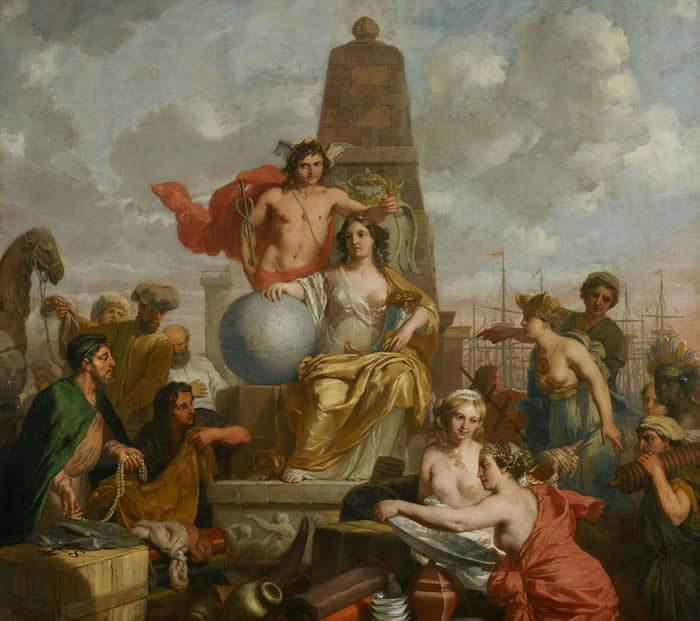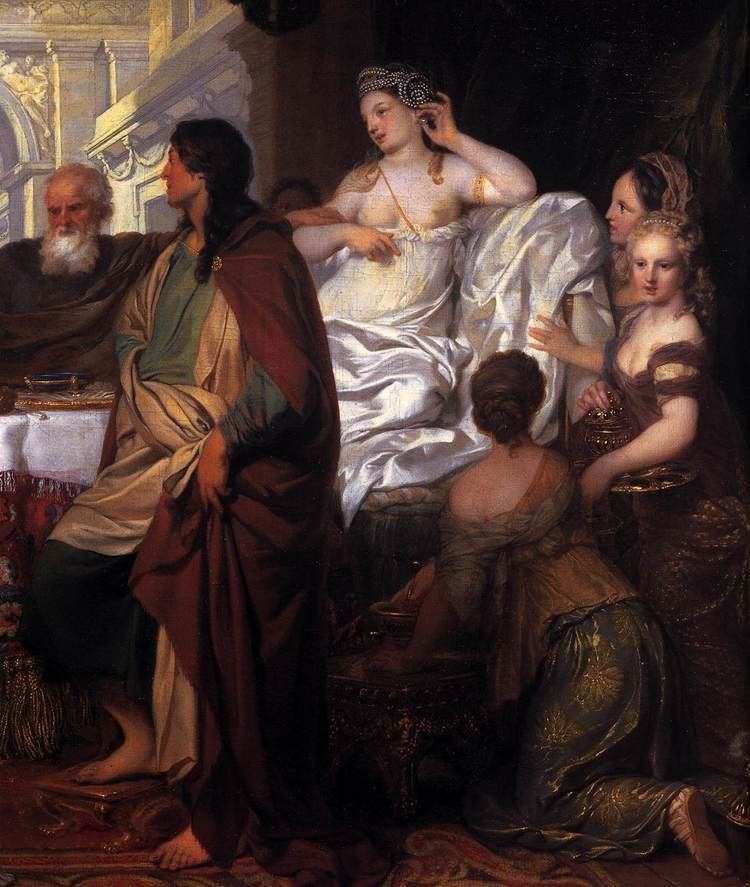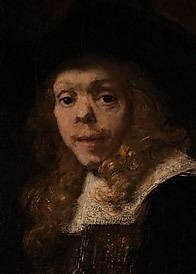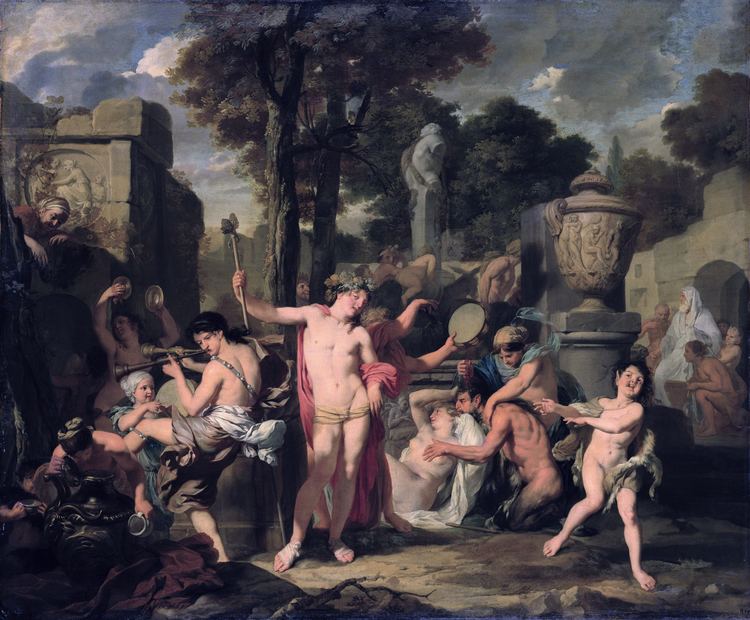Name Gerard Lairesse Role Author | Period Baroque Artwork Apollo and Aurora | |
 | ||
Died 1711, Amsterdam, Netherlands | ||
Gerard de lairesse maler
Gerard or Gérard (de) Lairesse (11 September 1641 – June 1711) was a Dutch Golden Age painter and art theorist. His broad range of talent included music, poetry, and theatre. De Lairesse was influenced by the Perugian Cesare Ripa and French classicist painters as Charles le Brun, Simon Vouet and authors as Pierre Corneille and Jean Racine. His importance grew in the period following the death of Rembrandt. His treatises on painting and drawing, Grondlegginge der teekenkonst (1701), based on geometry and Groot Schilderboek (1707), were highly influential on 18th-century painters.
Contents
- Gerard de lairesse maler
- Gerard de lairesse
- Painting career
- Style
- De Lairesse as art theorist
- Legacy
- Works
- References

Gerard de lairesse
Painting career

De Lairesse was born in Liège and was the second son of painter Renier de Lairesse (1597-1667). He studied art under his father and from 1655 under Bertholet Flemalle. He worked in Cologne and Aix-la-Chapelle for Maximilian Henry of Bavaria in 1660. In 1664 De Lairesse fled from Liège after an affair with two sisters, his models, went wrong. He traveled north with a girl named Marie Salme and married her in Visé. The couple settled in Utrecht, where a son was baptized in April 1665. When his talent was discovered by the art dealer Gerrit van Uylenburgh, he moved quickly to Amsterdam. De Lairesse arrived with his violin, with which he impressed Jan van Pee and probably Anthonie Claesz. de Grebber in Uylenburgh's studio. In 1667 De Lairesse became a poorter, living on Nieuwmarkt. In 1670 a son Abraham was born; the engraver Abraham Blooteling, with whom he collaborated, was the witness; another son was baptized in 1673.
In 1671, when Van Uylenburgh tried to sell 13 paintings to Frederick William, Elector of Brandenburg, Hendrick Fromantiou successfully advised the Elector to send 12 pieces back as forgeries. Fromantiou claimed the paintings were copies of Italian ones, and he could point out the originals in Holland. Included in the 51 people involved in the expertise, was De Lairesse.

At some time De Lairesse moved to Spinhuissteeg; he became a member of the literary society Nil volentibus arduum, which seems to have gathered in his house from 1676 till 1681. In 1682 he sold copied of sheet music, composed by Lully. In May 1684 he rented the nearby house of Caspar Barlaeus. His pupils Philip Tideman and Louis Abry lived there too.

De Lairesse produced paintings for the decoration of Soestdijk Palace between 1676 and 1683. In 1684 he moved to the Hague and worked there for a year. In the Binnenhof he decorated a hall, which is named after him, with an "Allegory of Justice". In 1685 he painted works for the Loo Palace. In 1687 he was visited by Nicodemus Tessin the Younger. On 27 November 1693, [his son] Abraham de Lairesse, from Amsterdam, painter, 27 (sic!) years old, living on the O.Z. Achterburgwal, assisted by his mother Maria Salme, was legally engaged to Johanna van Bevere, from Amsterdam. In 1697 he sold sheet music for his son Abraham who also sold (lined) paper and music sheets. Within a few years De Lairesse would change environment again and move to Prinsengracht, closer to his son. (His wife died in 1723.)
Style
At first, De Lairesse was highly influenced by Rembrandt, but later he focused on a more French-oriented style similar to Nicolas Poussin. The French even nicknamed him the "Dutch Poussin", but he was also influenced by Pierre Mignard and Charles Alphonse du Fresnoy.
In Amsterdam during the second half of the 17th century, the pious austerity and embarrassment of riches of the Protestant Dutch in Rembrandt's age had given way to unbridled opulence, even decadence, and de Lairesse's classical French, or Baroque, style fitted this age perfectly. It made him one of, if not the most popular painter in Amsterdam. De Lairesse was therefore frequently hired to adorn the interiors of government buildings and homes (canal houses) of wealthy Amsterdam businessmen with lavish grisailles, trompe l'oeil ceiling and wall paintings. Some of these paintings still exist in the original buildings where they were painted, but others were sold and can be seen on different spots.
De Lairesse as art theorist
De Lairesse suffered from hereditary or congenital syphilis, which caused him to go blind around 1690. The saddle nose which the disease gave him is clearly visible on the portrait which Rembrandt painted of him around 1665 and the engraving in the "Teutsche Academie" by Joachim von Sandrart (1683). After losing his sight, De Lairesse was forced to give up painting and focused instead on lecturing twice a week. De Lairesse explicitly states that despite his blindness, he is perfectly able to design a perfect composition. He drew on two chalk boards and was assisted by his audience and his son Johannes who collected their notes. After several years two books on art were published:
In Het groot schilderboeck, De Lairesse expressed his disapproval of realism by Dutch Golden Age painters like Rembrandt, Adriaen Brouwer, Adriaen van Ostade and Frans Hals because they often portrayed everyday scenes and ordinary people such as soldiers, farmers, maids, and even beggars. In De Lairesse's view, idealizing classicism, painting ought to show lofty biblical, mythological and historical scenes, in the spirit of Karel van Mander, who felt that a complex historical allegory was the highest of genres. "A good painting has a clue, indicating what holds the composition together."
He was a disciplined intellectual, inspired by the notion that only correct theory could produce good art. For him theory meant the strict adherence to rules. The ultimate purpose of the visual arts was the improvement of mankind, and therefore art must, above all, be lofty and edifying. He set forth hierarchies of social status, of subject matter, of beauty itself. The artist, he said, must learn grace by mingling with the social and intellectual élite, must allow his subject matter to teach the highest moral principles, and must strive for ideal beauty. He must follow closely upon nature but overlook its imperfections.
In the main reception room there should be tapestries or paintings on the wall with life size figures ... and in the kitchen, images of kitchen equipment and the spoils of the hunt, the picture of some maid, servant, dog or cat. De Lairesse, for whom pictorial illusionism was of utmost importance, also wrote about the place of pictures on walls. For example, he urged that landscapes (and indeed all paintings) should be hung at a height where their horizons were even with eye level. De Lairesse urged that portraits that be hung high and have a low viewpoint. Gerard de Lairesse was cognizant of the problems posed by viewing paintings from a distance and drew connection between the hanging position and the scale and style of individual paintings. He noted ... that a piece ten feet large, with life-size figures, should be viewed at ten feet distance, and that a smaller one five feet high, with life-size, half-length figures, must have five feet distance.
Legacy
His treatises on painting and drawing, Grondlegginge der teekenkonst (1701) and Het groot schilderboeck (1707), were highly influential on later painters like Jacob de Wit. He also worked with many established artists of his day, as Barend Graat, Johannes Glauber and Frederick de Moucheron, on larger commissions for house decorations.
De Lairesse attracted many pupils, including Jan van Mieris, Simon van der Does, and the brothers Teodor and Krzysztof Lubieniecki. According to Houbraken, Jan Hoogsaat was one of his best pupils. According to the RKD his pupils were Jacob van der Does (the Younger), Louis Fabritius Dubourg, Jan Goeree, Gilliam van der Gouwen, Johannes de Lairesse, Theodor Lubienitzki, Bonaventura van Overbeek, Jan Wandelaar, and Zacharias Webber (the Younger).
Celebrated during his lifetime and well into the 18th century, he was berated during the 19th century. With or without justification, he was considered superficial and effete, and was held in large part responsible for the decline in Dutch painting. Two hundred years after his death in 1711 the Encyclopædia Britannica, 11th Edition (1911) gave no listing at all for De Lairesse, while devoting four pages of solid text to Rembrandt.
Works by De Lairesse are now on display at many museums around the world, including the Rijksmuseum and Amsterdams Historisch Museum in Amsterdam, the Louvre in Paris, the Metropolitan Museum of Art in New York City, the National Gallery of Art in Washington, D.C., the National Portrait Gallery and Tate Gallery in London, and the Cleveland Museum of Art.
Works
Well-known paintings by de Lairesse include his Allegory of the Five Senses (1668), Diana and Endymion (ca. 1680) and Cleopatra Landing at Tarsus. Some of his paintings show influence by the Iconologia of Cesare Ripa, a book that was given to him by his brother, after returning from Italy. A versatile artist, De Lairesse also made many prints for book illustrations (e.g. for the poet Andries Pels) (1668). Among other things, De Lairesse produced:
